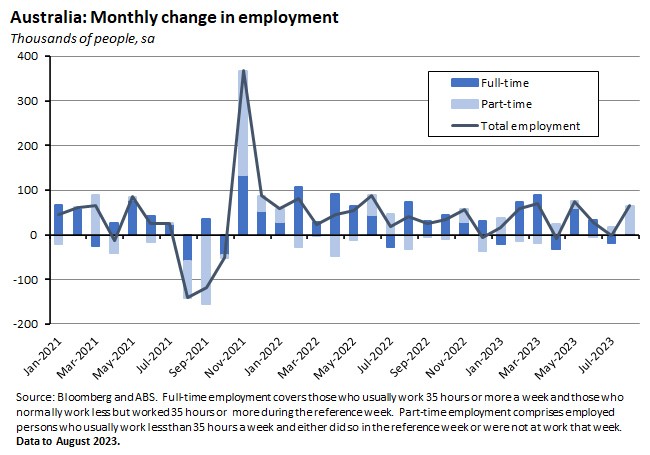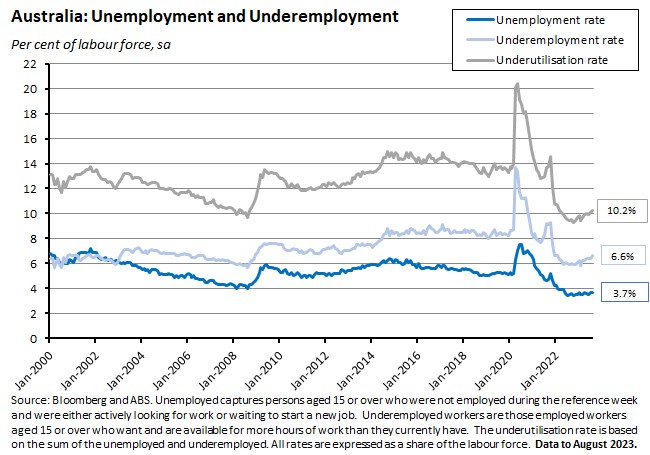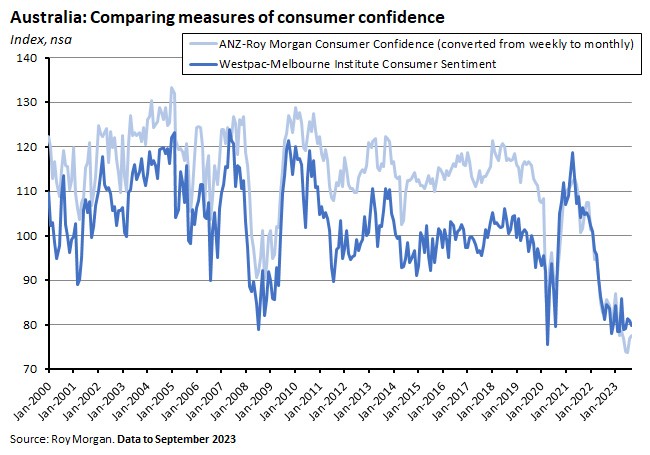Employment growth pleasantly surprised in August 2023, with the economy employing almost 65,000 more people than it had in the previous month. In turn, that helped the participation rate set a new record high of 67 per cent. After July’s relatively weak report, the latest set of Labour Force numbers prove that labour market resilience remains strong and hiring conditions tight, despite the impact of higher interest rates on demand and rapid growth in net overseas migration on labour supply.
There was probably enough in the detail here to prevent Martin Place from interpreting the result as a compelling case for another ‘insurance’ hike in the cash rate target next month. But this week’s release is a reminder that the cash rate profile for the next few months is not completely locked in.
Meanwhile, that still-robust labour market appears to be doing little for consumer sentiment. The latest round of indicators shows that confidence remained at extremely low levels earlier this month. True, the RBA’s extended pause appears to have delivered a degree of cheer to mortgage holders. But everyone else is still feeling squeezed by cost-of-living pressures including rising petrol prices and climbing rents. Conversely, the latest NAB monthly survey reports that business conditions in August remained robust while business confidence edged slightly higher over the month.
But until then, back to the detail…
Employment grew by almost 65,000 people in August
The August 2023 Labour Force data from the ABS showed employment rising by 64,900 people or 0.5 per cent over the month (seasonally adjusted), with full-time employment increasing by 2,800 and part-time employment jumping by 62,100.

Consistent with the strong headline employment growth, the participation rate rose 0.1 percentage point to a new record high of 67 per cent while the employment to population ratio rose by the same magnitude to 64.5 per cent to be in line with the record high set in June this year.
The unemployment rate in August was unchanged from July at 3.7 per cent although the underemployment rate climbed to 6.6 per cent from 6.4 per cent. That took the underutilisation rate up to 10.2 per cent from 10.1 per cent. And consistent with the rise in underemployment, the number of monthly hours worked fell by nine million hours or 0.5 per cent.

With the consensus forecast expecting an employment increase of 25,000 last month, the August result comfortably outpaced market expectations (although the median projection for the unemployment rate was on target). Add record highs for participation and the ratio of employment to population, and the data are clearly describing a still-tight labour market that, as of last month, had remained resilient in the face of slower growth and high interest rates.
Does the result signal more than that? Is this week’s labour market strong enough to count as one of those ‘surprises in the data indicating an upside risk to inflation’ that we said last week would be required to encourage the RBA to consider another rate hike? The bounce in employment numbers for August is a useful reminder that there are still some near-term upside risks to the profile for monetary policy over the coming months. But other details in the report suggest that this result on its own is unlikely to be enough to shift policy at Martin Place. For example, the rise in the underemployment and underutilisation rates indicate that the overall level of labour market slack increased last month, albeit only modestly. The fall in monthly hours worked sent a similar message. In addition, the ABS also noted that the large increase in August employment followed a drop in employment in July around the school holidays. The Bureau noted that over the past two months, employment growth has run at an average monthly rate of around 32,000 people, which is similar to the average growth rate recorded over the past year, implying that August (and July before that) may be less of an outlier relative to previous readings than they originally seemed.
Consumers miserable, mortgage holders cheered up
The monthly Westpac-Melbourne Institute Index of Consumer Sentiment fell 1.5 per cent to 79.7 in September 2023. Westpac noted that the low reading means that sentiment has been in ‘deeply pessimistic territory’ for more than a year, with the only comparable period of sustained weakness in the survey’s history occurring during the early 1990s recession, when even weaker levels held for more than two years. Still-high inflation and the associated cost of living pressures on family finances are key drivers of this weakness, with Westpac highlighting the 15 per cent rise in petrol prices over the past two months alongside rising costs for rent and electricity.
Somewhat more positively, there were signs that the RBA’s decision to leave the cash rate target unchanged for the past three board meetings is having an impact as confidence across mortgage holders rose 7.8 per cent over the month. That reflects a shift in interest rate expectations; among those surveyed after September’s RBA meeting, just 48 per cent expected rates to rise over the coming year, down from 68 per cent of those surveyed after the August meeting and breaking a run of two years when every survey found an outright majority of consumers expected rates to move higher. In terms of the overall result, however, this gain was more than offset by declines in confidence for renters (down 6.1 per cent) and among consumers who own their home outright (down 5.8 per cent).
Two other results worth noting:
- The Westpac-Melbourne Institute Unemployment Expectations Index rose 2.8 per cent over the month, indicating that more respondents expect a rise in unemployment over the year ahead. This index now stands 32 per cent higher than in the same month last year.
- The Westpac-Melbourne Institute House Price Expectations Index rose 2.2 per cent to set a new high for the current cycle. That leaves it only 5.5 per cent below the 2021 peak and 70 per cent above its November 2022 low. More than 65 per cent of respondents now expect prices to increase over the next 12 months.

The message of sustained weakness in consumer sentiment is also consistent with the latest reading from the weekly ANZ-Roy Morgan Consumer Confidence Index, which fell 1.1 points to 77.6 in the week ending 10 September, more than unwinding the previous week’s 0.6-point rise. The result means that weekly confidence readings have now been stuck below 80 for a record-breaking run of six months. ANZ highlighted a particularly sharp fall in confidence among renters last week – a sign that the accommodation shortage and consequent upward pressure on rents is taking a toll. The fact that the index dropped seems to indicate that last week’s RBA decision to leave the cash rate target unchanged did little for consumer confidence overall. Still, ANZ notes that although the level of confidence is lowest among those households with a mortgage, confidence among that latter group did climb to its highest level in five months, suggesting that the RBA’s pause may have had some positive effect after all in a result that is also consistent with the Westpac findings reported above.
The survey’s measure of ‘weekly inflation expectations’ eased by 0.1 percentage point to 5.2 per cent.
Business conditions and confidence both rose last month
According to the latest NAB monthly Business Survey, business conditions rose by three points to +13 index points in August 2023. All three subindices – trading (up one point to +18), profitability (up two points to +13) and employment (up three points to +9) – strengthened over the month to keep the index comfortably above its long-term average.
At the same time, the business confidence index also rose last month, lifting by one index point to +2 points from (a downwardly revised) +1 point in July, although this index remained below its long-term average. Other forward-looking indicators showed the rate of capacity utilisation rising to 85.1 per cent and its highest rate since March this year while the forward orders index edged up by one point to 0 index points.
Finally, in terms of price and cost pressures, the quarterly rate of growth in labour costs fell to 3.2 per cent in August from 3.7 per cent in July (the previous month’s result had reflected the impact of increases in minimum and award wages) but purchase cost growth picked up slightly in August, rising to 2.9 per cent from 2.8 per cent. Quarterly growth in final products prices was 1.7 per cent, down from 1.9 per cent in July.
Overall, NAB said the survey results indicated that the Australian economy had remained resilient into the third quarter of this year.
What else happened on the Australian data front this week?
Australia’s population was 26,473,055 people on 31 March this year. That was an annual increase of 563,200 people or 2.2 per cent. According to the ABS, annual natural increase was 108,800 (down by 24,700 people over the previous year) and net overseas migration was 454,400 (up by 362,500 people). Net overseas migration accounted for 81 per cent of total population growth, reflecting a large increase in arrivals (up 103 per cent over the year) and only a small increase in departures (up 8.8 per cent) as post-pandemic catchup effects dominated.
The ABS said there were 71 industrial disputes in the June quarter 2023, involving 10,500 employees and 10,200 working days lost. Over the year ending June 2023 there were 213 disputes and a total of 67,100 working days lost. The number of disputes was up from 154 in the same period last year but working days lost was down from 234,600.
The number of short-term visitor arrivals in July 2023 was 625,120, up 299,440 from the same month last year. The ABS said that the number of trips was still 20.9 per cent lower than the pre-COVID level recorded in July 2019. Total arrivals rose to 1,743,390 in July 2023, an annual increase of 661,790. For the 2022-23 financial year as a whole, there were nearly 5.9 million visitor arrivals, an increase of nearly 4.7 million travellers or almost five times the number recorded in the previous year, but still only 63 per cent of the number recorded in 2018-19.
The ABS said that the total value of residential dwellings in Australia rose by $325 billion to $10,090.6 billion in the June quarter 2023. The number of residential dwellings rose by 52,200 to 11,055,800 and their mean price increased by $25,200 to $912,700, ranging from a high of $1,167,500 in New South Wales to a low of $512,700 in the Northern Territory.
Last Friday the ABS published the June quarter 2023 edition of the Labour Account. The numbers showed total jobs up 0.7 per cent over the quarter (seasonally adjusted) to 15.8 million, filled jobs up 0.8 per cent to 15.4 million, and job vacancies down three per cent to 0.4 million (their third consecutive quarterly drop). The share of vacant jobs fell to 2.7 per cent from 2.8 per cent in the March quarter. The vacancy rate is now down significantly from the record high of 3.2 per cent it set in the September quarter of last year but is still well above the 1.6 per cent rate applying pre-pandemic, in the March quarter 2020. The ABS also reported that the number of people holding multiple jobs rose 0.8 per cent, with the share of multiple job holding setting a record high of 6.7 per cent. According to the Bureau, in the 25 years before the pandemic, this rate usually varied between five and six per cent, but has been trending higher over the past two years, such that while only one in 18 people held more than one job 20 years ago, now around one in 15 do.
The end of last week also saw the ABS release the July 2023 data for its Monthly Business Turnover Indicator. On a seasonally adjusted basis, seven of the 13 published industries reported a drop in turnover, with the largest decline in electricity, gas, water and waste services (down 14.9 per cent over the month, which the Bureau attributed to a large decrease in wholesale electricity prices), followed by Arts and recreation (down 6.1 per cent). The largest increase in turnover was for Administrative and support services (up 3.8 per cent) and Construction industries (up two per cent).
Other things to note . . .
- The September quarter 2023 Labour Market Update from Jobs and Skills Australia has been published. According to the report, not only did employment in Australia reach a record high in the May quarter of this year, but so did employment in seven broad industry groups: Health care and social assistance; Construction; Professional, scientific and technical services; Education and training; Accommodation and food services; Transport, postal and warehousing; and Mining.
- This New RBA Research Discussion Paper uses a large language model to derive insights from earnings calls on firms’ price-setting behaviour. The authors highlight four key findings related to the elasticity (sensitivity) of sentiment about final prices to input costs and demand after controlling for common supply shocks: (1) Final price sentiment is more closely correlated with sentiment about input costs than with sentiment about demand – consistent with the argument that firms tend to set prices as a mark-up over costs; (2) Firms react more to increasing than decreasing input costs – an asymmetry that means price pressures will stay front of mind even as supply pressures ease; (3) in the post-COVID period, discussions around final prices have become more sensitive to sentiment around import costs but less sensitive to rising labour costs; and (4) the association between price-setting sentiment and input cost/demand sentiment differs significantly across industries – suggesting the importance of detailed multisector models of the economy.
- Outgoing Productivity Commission Chair Michael Brennan’s recent speech to the Minerals Council of Australia.
- Chris Richardson in the AFR this week on why political constraints mean bigger GST is a reform killer (echoes some of the points made in the piece from John Quiggin linked to last week).
- Australia’s welfare 2023, from the Australian Institute of Health and Welfare.
- A speech from ACCC Chair Gina Cass-Gottlieb on the new Gas Market Code.
- A new dataset from the PBO – historical budget forecasts.
- From the FT, the IEA says that the world is at the ‘beginning of end’ of the fossil fuel era. New IEA forecasts in next month’s World Energy Outlook will project that demand for oil, gas and coal will all peak before 2030.
- The Economist asks, Does China face a lost decade?
- Dani Rodrik argues that the global economy’s real enemy is geopolitics, not protectionism.
- The WSJ thinks that a waning in global trade helps explain diverging economic performance across the world’s largest economies, allowing the relatively closed US and Indian economies to out-perform their more trade-dependent peers.
- Also from the WSJ, an essay on how the US stumbled into using chips as a weapon against China.
- The September 2023 issue of the IMF’s Finance & Development magazine focuses on the Middle East and North Africa.
- And the IMF says global debt is returning to its rising trend.
- William White argues that monetary policy should be guided more by financial sector developments such as credit and debt and less by near-term inflation targets.
- From the OECD, the revised G20/OECD principles of Corporate Governance and accompanying Corporate Governance Factbook 2023.
- Some neat visual storytelling from the FT on generative AI.
- Goldman Sachs reckons AI stocks aren’t in a bubble.
- Zeke Faux on SBF, crypto hype and ponzinomics (book extract).
- John Lanchester in the LRB considers the (sometimes problematic) role of data and statistics in modern politics, government and society and how this relates to the UK’s current problems. Includes a reference to the now infamous Reinhart and Rogoff spreadsheet error.
- On the drowning of Doggerland.
- A bunch of podcasts to wrap up. First, a Grattan Institute podcast on National Cabinet and the Housing Crisis. Then, two from the These Times podcast, the first on Africa’s Coup Belt, the second on Saudi Arabia. And finally, the Joe Walker podcast in conversation with Peter Turchin on Cliodynamics and Why societies fall apart.
Latest news
Already a member?
Login to view this content



